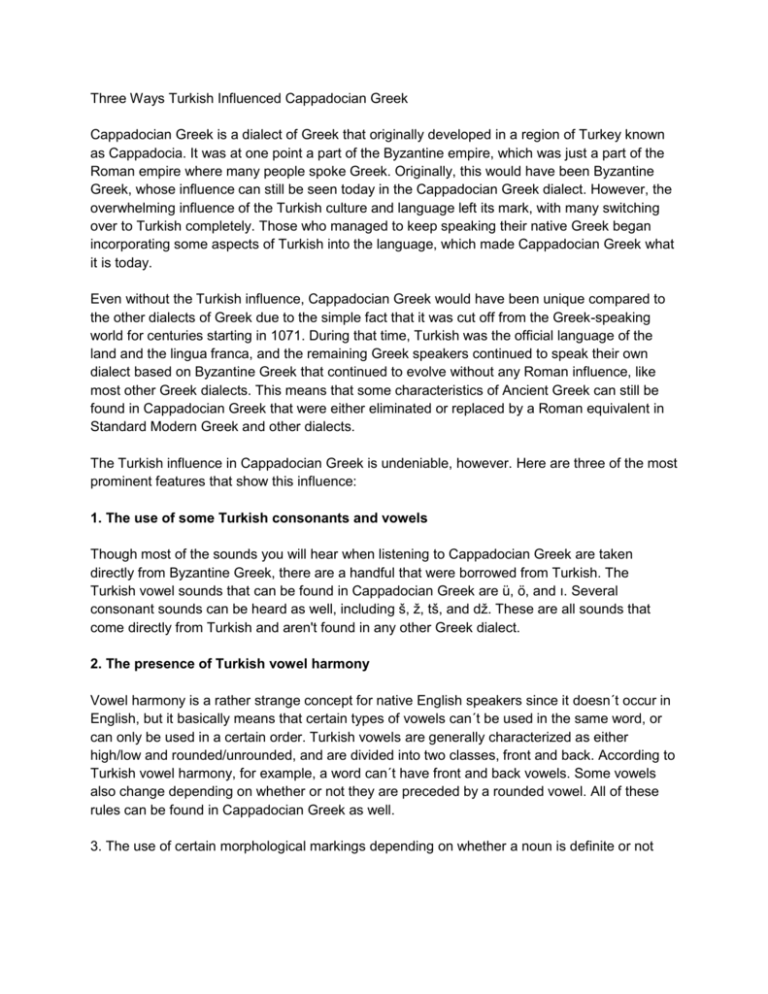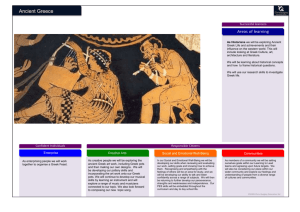3WaysTurkishInfluencedCappadocianGreek
advertisement

Three Ways Turkish Influenced Cappadocian Greek Cappadocian Greek is a dialect of Greek that originally developed in a region of Turkey known as Cappadocia. It was at one point a part of the Byzantine empire, which was just a part of the Roman empire where many people spoke Greek. Originally, this would have been Byzantine Greek, whose influence can still be seen today in the Cappadocian Greek dialect. However, the overwhelming influence of the Turkish culture and language left its mark, with many switching over to Turkish completely. Those who managed to keep speaking their native Greek began incorporating some aspects of Turkish into the language, which made Cappadocian Greek what it is today. Even without the Turkish influence, Cappadocian Greek would have been unique compared to the other dialects of Greek due to the simple fact that it was cut off from the Greek-speaking world for centuries starting in 1071. During that time, Turkish was the official language of the land and the lingua franca, and the remaining Greek speakers continued to speak their own dialect based on Byzantine Greek that continued to evolve without any Roman influence, like most other Greek dialects. This means that some characteristics of Ancient Greek can still be found in Cappadocian Greek that were either eliminated or replaced by a Roman equivalent in Standard Modern Greek and other dialects. The Turkish influence in Cappadocian Greek is undeniable, however. Here are three of the most prominent features that show this influence: 1. The use of some Turkish consonants and vowels Though most of the sounds you will hear when listening to Cappadocian Greek are taken directly from Byzantine Greek, there are a handful that were borrowed from Turkish. The Turkish vowel sounds that can be found in Cappadocian Greek are ü, ö, and ı. Several consonant sounds can be heard as well, including š, ž, tš, and dž. These are all sounds that come directly from Turkish and aren't found in any other Greek dialect. 2. The presence of Turkish vowel harmony Vowel harmony is a rather strange concept for native English speakers since it doesn´t occur in English, but it basically means that certain types of vowels can´t be used in the same word, or can only be used in a certain order. Turkish vowels are generally characterized as either high/low and rounded/unrounded, and are divided into two classes, front and back. According to Turkish vowel harmony, for example, a word can´t have front and back vowels. Some vowels also change depending on whether or not they are preceded by a rounded vowel. All of these rules can be found in Cappadocian Greek as well. 3. The use of certain morphological markings depending on whether a noun is definite or not Something that can be found in Turkish is a tendency add a suffix or not to a noun depending on whether it is a definite or indefinite noun. In Cappadocian Greek, this characteristic can be seen when a noun is in the accusative case. In order to show that it is definite or indefinite, a suffix is added (or not), just as in Turkish.









